Problem Set 6 Solutions
Problem Set 6 Solutions
Problem Set 6 Solutions
You also want an ePaper? Increase the reach of your titles
YUMPU automatically turns print PDFs into web optimized ePapers that Google loves.
Econ 252 Spring 2011 <strong>Problem</strong> <strong>Set</strong> 6 – Solution Professor Robert Shiller<br />
Econ 252 - Financial Markets<br />
Spring 2011<br />
Professor Robert Shiller<br />
<strong>Problem</strong> <strong>Set</strong> 6 – Solution<br />
Question 1<br />
(a) A futures contract is an obligation to trade at a future date at a price specified in<br />
the contract, and an options contract is a right, but not an obligation, to trade at a<br />
future date at a price specified in the contract. Investors use futures to protect<br />
against symmetric risk and options to protect against asymmetric risk.<br />
(b) The correct answer is the second alternative. The farmer should sell futures<br />
contracts for 20,000 bushels with a futures price of $7 and delivery in 3 months.<br />
He then can sell at $7, no matter what the market price is. Therefore, he can<br />
make exactly $140,000 and pay back his loan.<br />
If he purchases those futures contracts, then the futures contract obligates him<br />
to purchase corn in 3 months, which he does not need. If he buys put options<br />
with a strike price of $2, he obtains the right to sell the corn at $2 per bushel, and<br />
this would not be enough to cover his debt.
Econ 252 Spring 2011 <strong>Problem</strong> <strong>Set</strong> 6 – Solution Professor Robert Shiller<br />
(c) The correct answer is the third alternative. Because the manager believes that<br />
the stock price will down to $25 in 6 months, he would like to place a bet<br />
reflecting this pessimistic outlook. So, the manager should purchase put options<br />
with a strike price of $30 maturity maturing in 6 months.<br />
If the investor purchases the call option from the first alternative, and the stock<br />
price falls below $30, the option will be out of the money, and he might end up<br />
with a negative profit. If he purchases the future from the second alternative,<br />
then he gains if the spot price is higher than $30 six months from now, but he<br />
incurs a loss if the stock price falls below $30. As he believes that stock price will<br />
go down to $25 in 6 months, neither this call nor this future will be appropriate<br />
for him.
Econ 252 Spring 2011 <strong>Problem</strong> <strong>Set</strong> 6 – Solution Professor Robert Shiller<br />
Question 2<br />
(a) The payoff of the described call option at maturity is as follows:<br />
Underlying ST≤40 ST>40<br />
Payoff<br />
Call C1 with E=40<br />
0 ST-40<br />
The cost of the call option is $8. It follows that the profit of the described call<br />
option at maturity is as follows:<br />
Underlying ST≤40 ST>40<br />
Profit<br />
Call C1 with E=40<br />
-8 ST-48
Econ 252 Spring 2011 <strong>Problem</strong> <strong>Set</strong> 6 – Solution Professor Robert Shiller<br />
(b) The payoff of the described put option at maturity is as follows:<br />
Underlying ST≤40 ST>40<br />
Payoff<br />
Put P1 with E=40<br />
40-ST 0<br />
The cost of the put option is $12. It follows that the profit of the described put<br />
option at maturity is as follows:<br />
Underlying ST≤40 ST>40<br />
Profit<br />
Put P1 with E=40<br />
28-ST -12
Econ 252 Spring 2011 <strong>Problem</strong> <strong>Set</strong> 6 – Solution Professor Robert Shiller<br />
(c) The payoff of the described portfolio at maturity is obtained as follows:<br />
Underlying ST≤40 ST>40<br />
Payoff<br />
0 ST-40<br />
Call C1 with E=40<br />
Payoff<br />
40-ST 0<br />
Put P1 with E=40<br />
Payoff Portfolio<br />
C1+P1<br />
40-ST ST-40<br />
The portfolio C1+P1 costs $8+$12=$20. It follows that the profit of the portfolio<br />
at maturity is as follows:<br />
Underlying ST≤40 ST>40<br />
Profit Portfolio<br />
C1+P1<br />
20-ST ST-60<br />
An investor might want to construct this portfolio if he thinks that the stock will<br />
move substantially between the time of construction and the maturity date,<br />
without knowing in which direction the stock will move.
Econ 252 Spring 2011 <strong>Problem</strong> <strong>Set</strong> 6 – Solution Professor Robert Shiller<br />
(d) The payoff of the described portfolio at maturity is obtained as follows:<br />
Underlying ST≤40 4050<br />
Payoff<br />
0 ST-40 ST-40<br />
Call C1 with E=40<br />
Payoff<br />
0 0 ST-50<br />
Call C2 with E=50<br />
Payoff Portfolio<br />
C1-C2<br />
0 ST-40 10<br />
The portfolio C1-C2 costs $8-$5=$3. It follows that the profit of the portfolio at<br />
maturity is as follows:<br />
Underlying ST≤40 4050<br />
Profit Portfolio<br />
C1-C2<br />
-3 ST-43 7<br />
An investor might want to construct this portfolio if he thinks that the price of<br />
the stock will go up moderately between the time of construction and the<br />
maturity date. Moreover, he puts a limit on his losses if the stock decreases.
Econ 252 Spring 2011 <strong>Problem</strong> <strong>Set</strong> 6 – Solution Professor Robert Shiller<br />
(e) The payoff and the profit of the described portfolio are as follows:<br />
Underlying ST≤40 40
Econ 252 Spring 2011 <strong>Problem</strong> <strong>Set</strong> 6 – Solution Professor Robert Shiller<br />
Question 3<br />
The price of the underlying XYZ evolves as follows:<br />
• A year from now:<br />
S(u) = u⋅ S(0) =150,S(d) = d⋅ S(0) = 50.<br />
• Two years from now:<br />
S(uu) = u 2 ⋅ S(0) = 225,S(ud) = S(du) = u⋅ d⋅ S(0) = 75,S(dd) = d 2 ⋅ S(0) = 25.<br />
(a) The one-period Binomial Asset Pricing Model has the following schematic form:<br />
The one-period hedge ratio for the call option C1 is<br />
H =<br />
C(u) − C(d)<br />
(u − d)S(0)<br />
⇔ H =<br />
max[150 − 30,0] − max[50 − 30,0]<br />
(1.5 − 0.5)⋅ 100<br />
=1.<br />
The hedge ratio denotes the number of stocks you want to hold per option sold<br />
in order to construct a hedge portfolio, which generates the same payoffs in each<br />
state of the world. This means that the hedge portfolio is riskless. Therefore, an<br />
investor has two possibilities to transfer money from period 0 to period 1, the<br />
hedge portfolio and investing at the risk-free rate.<br />
It then follows from the no-arbitrage principle that these two possibilities must<br />
have the same return, i.e. the rate of return for investing in the hedge portfolio<br />
must equal r. Knowing the value of the hedge portfolio in a subsequent period<br />
and the return of the hedge portfolio therefore determines the value of the call<br />
option today.
Econ 252 Spring 2011 <strong>Problem</strong> <strong>Set</strong> 6 – Solution Professor Robert Shiller<br />
(b) The desired quantity is C1(0), which satisfies the following identity:<br />
H⋅ S(u) − C 1<br />
(u)<br />
H⋅ S(0) − C 1<br />
(0)<br />
⇔ C 1<br />
(0) = 76.<br />
=1+ r ⇔<br />
1⋅ 150 − max[150 − 30,0]<br />
1⋅ 100 − C 1<br />
(0)<br />
=1.25<br />
(c) The one-period Binomial Asset Pricing Model has the following schematic form:<br />
The desired quantity C2(0) will be obtained via backward induction.<br />
At the upper node in period 1, that is, after the stock price increases once:<br />
H(u) = C 2 (uu) − C 2 (ud)<br />
(u − d)⋅ S(u)<br />
⇔ H(u) =<br />
max[225 − 30,0] − max[75 − 30,0]<br />
(1.5 − 0.5)⋅ 150<br />
=1.<br />
Furthermore, the price of C2 at the upper node in period 1 satisfies the following<br />
identity:<br />
H⋅ S(uu) − C 2<br />
(uu)<br />
H⋅ S(u) − C 2<br />
(u)<br />
⇔ C 2<br />
(u) =126.<br />
1⋅ 225 − max[225 − 30,0]<br />
=1+ r ⇔ =1.25<br />
1⋅ 150 − C 2<br />
(u)
Econ 252 Spring 2011 <strong>Problem</strong> <strong>Set</strong> 6 – Solution Professor Robert Shiller<br />
At the bottom node in period 1, that is, after the stock price increases once:<br />
H(d) = C 2 (du) − C 2 (dd)<br />
(u − d)⋅ S(d)<br />
⇔ H(d) =<br />
max[75 − 30,0] − max[25 − 30,0]<br />
(1.5 − 0.5)⋅ 50<br />
= 0.9.<br />
Furthermore, the price of C2 at the bottom node in period 1 satisfies the<br />
following identity:<br />
H⋅ S(du) − C 2<br />
(du)<br />
H⋅ S(d) − C 2<br />
(d)<br />
⇔ C 2<br />
(d) = 27.<br />
=1+ r ⇔<br />
Hence, C2(d)=$27 is the answer to the first question.<br />
0.9⋅ 75 − max[75 − 30,0]<br />
0.9⋅ 50 − C 2<br />
(d)<br />
=1.25<br />
Finally, at the initial node:<br />
H(0) = C 2 (u) − C 2 (d)<br />
(u − d)⋅ S(0) ⇔ H(0) = 126 − 27<br />
(1.5 − 0.5)⋅ 100 = 0.99.<br />
Furthermore, the price of C2 at the initial node satisfies the following identity:<br />
H⋅ S(u) − C 2<br />
(u)<br />
H⋅ S(0) − C 2<br />
(0)<br />
⇔ C 2<br />
(0) = 81.<br />
=1+ r ⇔<br />
0.99⋅ 150 −126<br />
0.99⋅ 100 − C 2<br />
(0) =1.25<br />
Hence, C2(0)=$81 is the answer to the second question.<br />
(d) The price of the call-option has increased from $76 to $81, as the maturity of the<br />
call option has increased from one year to two years. This result is intuitive for<br />
call options, as a call-option becomes more valuable for higher stock prices.<br />
When the maturity becomes longer, the range of possible prices for the stock<br />
increases. The strike price of the call option however “cuts off” the bottom part<br />
of this range, leaving only the higher range of the stock price. This benefits the<br />
value of the call option.
Econ 252 Spring 2011 <strong>Problem</strong> <strong>Set</strong> 6 – Solution Professor Robert Shiller<br />
(e) Recall that the put-call parity is<br />
where T denotes time to maturity. It holds at any time period and for any state of<br />
the stock price evolution.<br />
C +<br />
E<br />
(1+ r) T = S + P,<br />
Therefore, the price of a 2-year put with the same strike price as C2 a year from<br />
now after the price has gone down once is<br />
30<br />
27 + = 50 + P(d) ⇔ P(d) =1.<br />
1+ 0.25<br />
Analogously, the price of this put option today is:<br />
81+<br />
30<br />
2<br />
=100 + P(0) ⇔ P(0) = 0.2.<br />
(1+ 0.25)
Econ 252 Spring 2011 <strong>Problem</strong> <strong>Set</strong> 6 – Solution Professor Robert Shiller<br />
Question 4<br />
The Black-Scholes formula is<br />
C = S⋅ N(d 1<br />
) − e −r⋅T ⋅ E⋅ N(d 2<br />
),<br />
where d1 and d2 are defined as follows:<br />
⎛<br />
ln S ⎞<br />
⎜ ⎟ + r⋅ T + σ2 ⋅ T<br />
⎝ E ⎠ 2<br />
d 1<br />
=<br />
,<br />
σ⋅ T<br />
⎛<br />
ln S ⎞<br />
⎜ ⎟ + r⋅ T − σ2 ⋅ T<br />
⎝ E ⎠ 2<br />
d 1<br />
=<br />
.<br />
σ⋅ T<br />
The notation is hereby as follows:<br />
• C is the current price of a European call option written on a stock with<br />
strike price E and time to maturity T,<br />
• S is the current price of the underlying stock,<br />
• r is the risk-free interest rate,<br />
• σ is the standard deviation of the return on the underlying stock,<br />
• N is the cumulative normal distribution function.<br />
(a) According to the information given, it follows that<br />
⎛<br />
ln S ⎞<br />
⎜ ⎟ + r⋅ T + σ2 ⋅ T ⎛<br />
ln 200 ⎞<br />
⎜ ⎟ + 0.2⋅ 4 + (0.5)2 ⋅ 4<br />
⎝ E ⎠ 2 ⎝ 120⎠<br />
2<br />
d 1<br />
=<br />
=<br />
≈1.8108,<br />
σ⋅ T<br />
0.5⋅ 4<br />
⎛<br />
ln S ⎞<br />
⎜ ⎟ + r⋅ T − σ2 ⋅ T ⎛<br />
ln 200 ⎞<br />
⎜ ⎟ + 0.2⋅ 4 − (0.5)2 ⋅ 4<br />
⎝ E ⎠ 2 ⎝ 120⎠<br />
2<br />
d 2<br />
=<br />
=<br />
≈ 0.8108.<br />
σ⋅ T<br />
0.5⋅ 4<br />
Hence, the price of the desired call-option is given by<br />
C = S⋅ N(d 1<br />
) − e −r⋅T ⋅ E⋅ N(d 2<br />
) ≈ 200⋅ N(1.8108) − e −0.2⋅4 ⋅ 120⋅ N(0.8108) ≈150.31.
Econ 252 Spring 2011 <strong>Problem</strong> <strong>Set</strong> 6 – Solution Professor Robert Shiller<br />
(b) Recall that the put-call parity is<br />
C + e −r⋅T ⋅ E = S + P,<br />
where the only new variable is P, which denotes the price of a put option that<br />
has the same underlying, the same strike price, and the same time to maturity as<br />
the call-option whose current price is denoted by C.<br />
Therefore, the price of a 4-year put with the same strike price as the call option<br />
in part (a) is<br />
150.31+ e −0.2⋅4 ⋅ 120 = 200 + P ⇔ P ≈ 4.23.
Econ 252 Spring 2011 <strong>Problem</strong> <strong>Set</strong> 6 – Solution Professor Robert Shiller<br />
(c) According to the information given, it follows that<br />
⎛<br />
ln S ⎞<br />
⎜ ⎟ + r⋅ T + σ2 ⋅ T ⎛<br />
ln 200 ⎞<br />
⎜ ⎟ + 0.2⋅ 4 + (0.4)2 ⋅ 4<br />
⎝ E ⎠ 2 ⎝ 120⎠<br />
2<br />
d 1<br />
=<br />
=<br />
≈ 2.0385,<br />
σ⋅ T<br />
0.4⋅ 4<br />
⎛<br />
ln S ⎞<br />
⎜ ⎟ + r⋅ T − σ2 ⋅ T ⎛<br />
ln 200 ⎞<br />
⎜ ⎟ + 0.2⋅ 4 − (0.4)2 ⋅ 4<br />
⎝ E ⎠ 2 ⎝ 120⎠<br />
2<br />
d 2<br />
=<br />
=<br />
≈1.2385.<br />
σ⋅ T<br />
0.4⋅ 4<br />
Hence, the price of the desired call-option is given by<br />
C = S⋅ N(d 1<br />
) − e −r⋅T ⋅ E⋅ N(d 2<br />
) ≈ 200⋅ N(2.0385) − e −0.2⋅4 ⋅ 120⋅ N(1.2385) ≈147.75.<br />
According to the put-call parity, the price of a 4-year put with the same strike<br />
price as the call option above is<br />
147.75 + e −0.2⋅4 ⋅ 120 = 200 + P ⇔ P ≈1.67.<br />
Both the price of the call and the put option decreases in response to a decrease<br />
of the volatility of the underlying stock.<br />
First, consider the call option. It becomes more valuable for higher stock prices<br />
and “cuts off” stock prices below the strike price. Therefore, as stock prices are<br />
less far apart because of the lower volatility, the call option becomes less<br />
valuable.<br />
Second, consider the put option. It becomes more valuable for lower stock prices<br />
and “cuts off” stock prices above the strike price. Therefore, as stock prices are<br />
less far apart because of the lower volatility, the put option also becomes less<br />
valuable.
Econ 252 Spring 2011 <strong>Problem</strong> <strong>Set</strong> 6 – Solution Professor Robert Shiller<br />
(d) According to the information given, it follows that<br />
⎛<br />
ln S ⎞<br />
⎜ ⎟ + r⋅ T + σ2 ⋅ T ⎛<br />
ln 200 ⎞<br />
⎜ ⎟ + 0.2⋅ 4 + (0.5)2 ⋅ 4<br />
⎝ E ⎠ 2 ⎝ 100⎠<br />
2<br />
d 1<br />
=<br />
=<br />
≈1.9931,<br />
σ⋅ T<br />
0.5⋅ 4<br />
⎛<br />
ln S ⎞<br />
⎜ ⎟ + r⋅ T − σ2 ⋅ T ⎛<br />
ln 200 ⎞<br />
⎜ ⎟ + 0.2⋅ 4 − (0.5)2 ⋅ 4<br />
⎝ E ⎠ 2 ⎝ 100⎠<br />
2<br />
d 2<br />
=<br />
=<br />
≈ 0.9931.<br />
σ⋅ T<br />
0.5⋅ 4<br />
Hence, the price of the desired call-option is given by<br />
C = S⋅ N(d 1<br />
) − e −r⋅T ⋅ E⋅ N(d 2<br />
) ≈ 200⋅ N(1.9931) − e −0.2⋅4 ⋅ 100⋅ N(0.9931) ≈157.65.<br />
According to the put-call parity, the price of a 4-year put with the same strike<br />
price as the call option above is<br />
157.65 + e −0.2⋅4 ⋅ 100 = 200 + P ⇔ P ≈ 2.58.<br />
The price of the call increases in response to the decrease in the strike price. In<br />
contrast, the price of the put option decreases in response to the decrease in the<br />
strike price.<br />
First, consider the call option. It becomes more valuable for higher stock prices<br />
and “cuts off” stock prices below the strike price. The decrease in the strike price<br />
therefore decreases the region for which the option “cuts off” the stock price and<br />
increases the value of the option for higher stock prices.<br />
Second, consider the put option. It becomes more valuable for lower stock prices<br />
and “cuts off” stock prices above the strike price. The decrease in the strike price<br />
therefore increases the region for which the option “cuts off” the stock price and<br />
decreases the value of the option for lower stock prices.


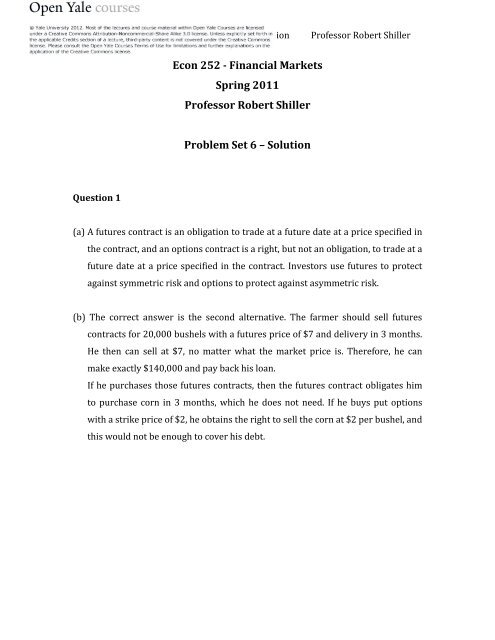
![Correction to Lecture 19 on the energy in a vibrating string [PDF]](https://img.yumpu.com/51237464/1/184x260/correction-to-lecture-19-on-the-energy-in-a-vibrating-string-pdf.jpg?quality=85)

![Final Exam Study Guide [PDF] - Open Yale Courses - Yale University](https://img.yumpu.com/51081618/1/190x245/final-exam-study-guide-pdf-open-yale-courses-yale-university.jpg?quality=85)

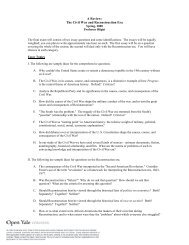
![Problem Set 3 [PDF]](https://img.yumpu.com/50264188/1/190x245/problem-set-3-pdf.jpg?quality=85)
![Multiple-Choice Quiz (with answer key) [PDF]](https://img.yumpu.com/50040467/1/190x245/multiple-choice-quiz-with-answer-key-pdf.jpg?quality=85)
![Midterm Exam 2 Preparation Guide [PDF] - Open Yale Courses](https://img.yumpu.com/49765365/1/190x245/midterm-exam-2-preparation-guide-pdf-open-yale-courses.jpg?quality=85)
![Problem Set Solutions 4 [PDF] - Open Yale Courses](https://img.yumpu.com/49644297/1/184x260/problem-set-solutions-4-pdf-open-yale-courses.jpg?quality=85)
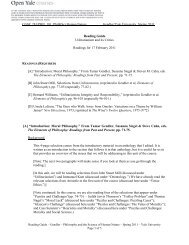
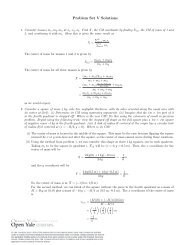
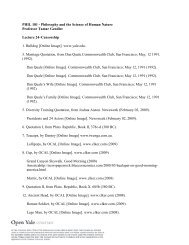
![Problem Set 7 [PDF]](https://img.yumpu.com/48179491/1/184x260/problem-set-7-pdf.jpg?quality=85)
![Problem Set Solutions 7 [PDF] - Open Yale Courses](https://img.yumpu.com/47648756/1/184x260/problem-set-solutions-7-pdf-open-yale-courses.jpg?quality=85)
![Topics for Paper 2 [PDF] - Open Yale Courses](https://img.yumpu.com/47038638/1/190x245/topics-for-paper-2-pdf-open-yale-courses.jpg?quality=85)